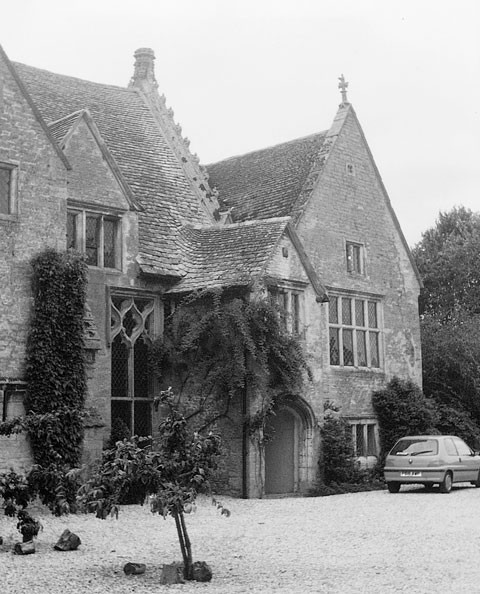
Northborough Manor, County of Cambridgeshire, England, built beginning ca. 1333. James Claypoole (1532/34–1599), grandfather of James Claypoole, (1634–1687) who came to Philadelphia in 1683, purchased the manor in 1572. The younger James was born in this house in 1634. (Photo, Brian Davies.)
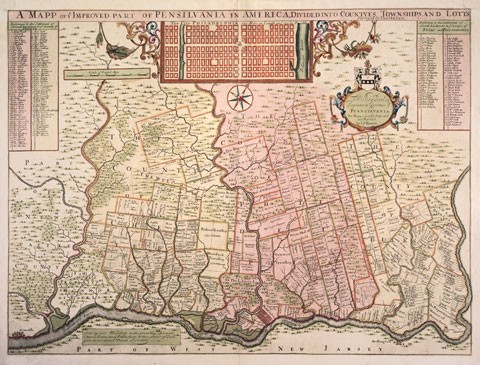
Thomas Holme (1624–1695), A Mapp of Ye Improved Part of Pensilvania in America, London, ca. 1700. Hand colored engraving. 12 1/8" x 18". (Private collection; photo, Lynne Rosenthal.) James Claypoole’s land appears on this early map to the left of the tract designated “German Township.” His eldest son John, who worked as an assistant to Thomas Holme, likely played a part in its creation. The engraving is by George Willdey.
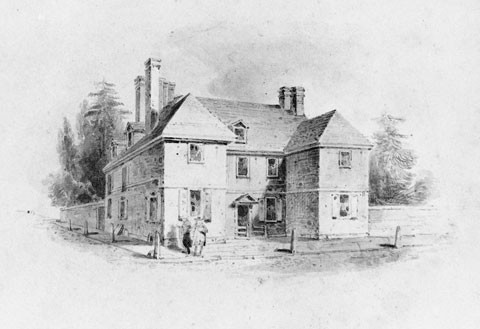
Samuel Carpenter’s Mansion, attributed to George Strickland, Philadelphia, Pennsylvania, 1825–1845. Ink wash on card. 5 5/8" x 7 1/8". (Private collection; photo, Schwarz Gallery, Philadelphia.) During his second trip to Pennsylvania, William Penn resided in Carpenter’s home (built ca. 1687– 1699). Carpenter’s house was located near James Claypoole’s residence on Second Street, but the former did not begin construction until shortly after the latter’s death.

Fall-front desk signed by Edward Evans, Philadelphia, Pennsylvania, 1707. Walnut with white cedar and white pine. H. 66 1/2", W. 44 1/2", D. 19 7/8". (Courtesy, Colonial Williamsburg Foundation.) This desk is the earliest signed and dated piece of furniture from Pennsylvania.
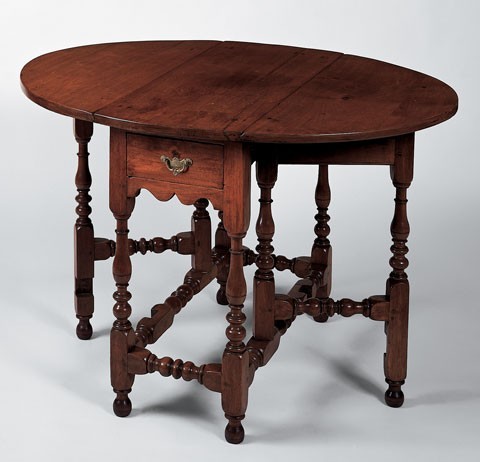
Oval table, Philadelphia, Pennsylvania, 1700–1730. Walnut with tulip poplar and white cedar. H. 29", W. 43 1/4" (open). (Courtesy, National Society of the Colonial Dames of America in the Commonwealth of Pennsylvania at Stenton.) James Logan also purchased oval tables from Edward Evans (1714/15), John Widdowfield (1717), and Thomas Staplefoot (1717). This example, which reputedly belonged to Logan, may represent the work of Joseph Claypoole or one of the aforementioned artisans.
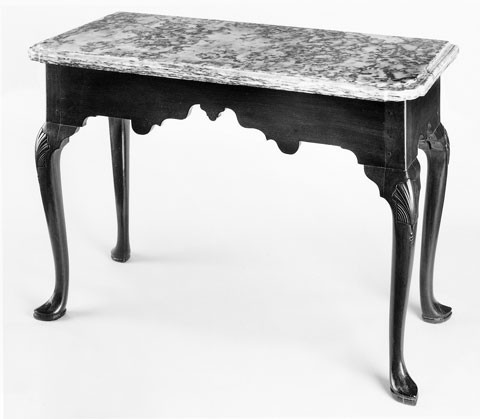
Side table, American, Philadelphia, Pennsylvania, maker unknown, 1740–1760. Mahogany; tulip poplar secondary wood; marble. Base: H. 28 7/8", W. 43", D. 18 1/2". Marble top: H. 1 3/8", W. 44 3/4", D. 21 1/2". (Courtesy, The Baltimore Museum of Art, bequest of J. Gilman D’Arcy Paul, BMA 1972.27.8; photo, Gavin Ashworth.) This example probably resembles the “sideboards” and “frames for marble” that Josiah Claypoole advertised between 1738 and 1740. Presumably, he learned to make such tables in Joseph’s shop.
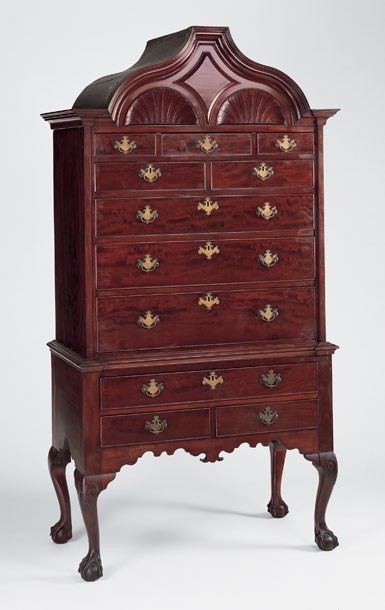
High chest signed by Joseph Claypoole, Philadelphia, Pennsylvania, 1743. Mahogany with maple, tulip poplar, white cedar, and yellow pine. H. 84 1/8", W. 44 1/8", D. 23 1/4". (Courtesy, Philadelphia Museum of Art, gift of Martin A. Battestin.) This is a unique example of an ogee head on a high chest of drawers.
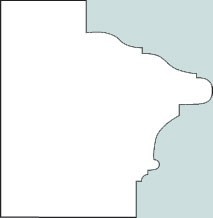
Drawing showing the molding profiles of the high chest illustrated in fig. 7.
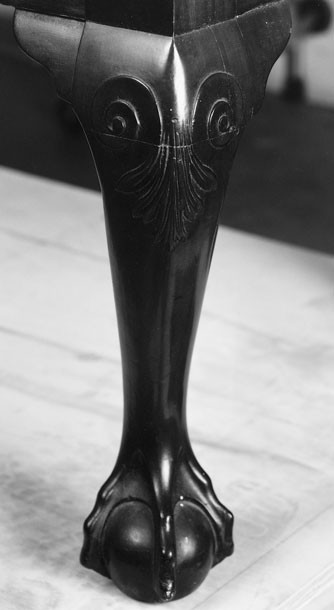
Detail of the left front leg and foot of the high chest illustrated in fig. 7. The naturalistic design and assured carving suggests that Joseph Claypoole’s shop produced claw-and-ball feet before 1743.
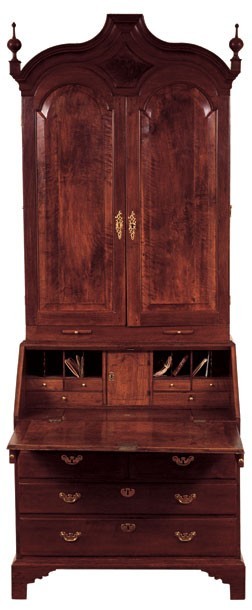
Desk-and-bookcase, Philadelphia, Pennsylvania, 1730–1745. Mahogany with cedar, oak, and tulip poplar. H. 98", W. 38 3/4", D. 22 3/4". (Courtesy, Wyck Association; photo, Eric Mitchell.) This desk has a history of descent in the Wistar family. Probable candidates for its maker are Joseph Claypoole or George Claypoole, Sr.

Desk-and-bookcase, Philadelphia, Pennsylvania, 1730–1745. Mahogany with maple, oak, pine, and tulip poplar. H. 96", W. 40", D. 24 1/4". (Courtesy, Tryon Palace Historic Sites and Gardens, New Bern, North Carolina.)
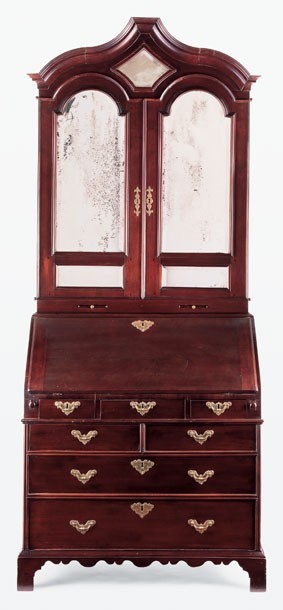
Desk-and-bookcase attributed to Stephen Armitt, Philadelphia, Pennsylvania, 1725–1740. Mahogany and exotic hardwoods with cedar, oak, and tulip poplar. H. 94", W. 34 3/4", D. 22". (Courtesy, National Society of the Colonial Dames of America in the Commonwealth of Pennsylvania at Stenton.)

Stenton, Germantown, Pennsylvania, built 1727–1730. (Courtesy, National Society of the Colonial Dames of America in the Commonwealth of Pennsylvania at Stenton.)
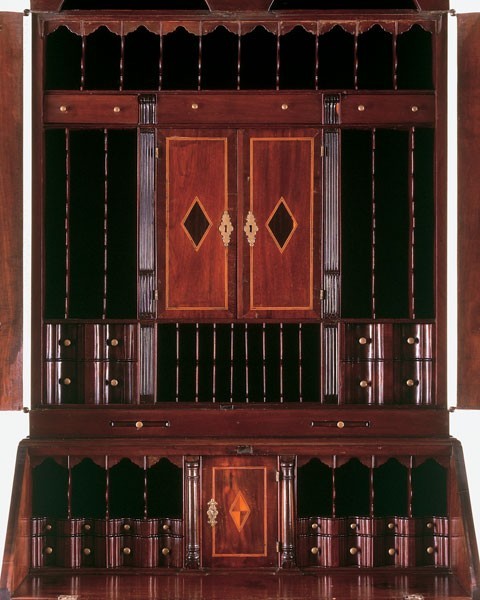
Detail of the interior of the desk-and-bookcase illustrated in fig. 12.

Desk-and-bookcase, Philadelphia, Pennsylvania, 1730–1745. Mahogany with yellow pine and tulip poplar. H. 89", W. 41 1/8", D. 24 3/4". (Private collection; photo, Philadelphia Museum of Art.)
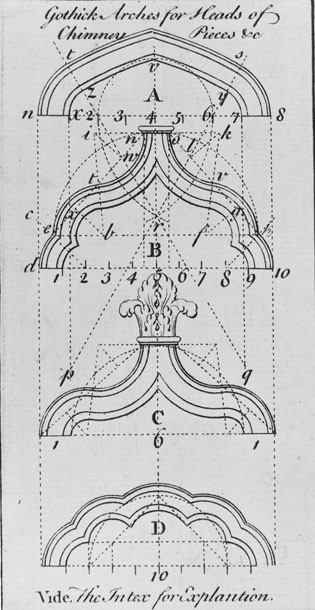
Pediment designs illustrated on p. 186 in Batty and Thomas Langley’s The Builder’s Jewell, or Youth’s Instructor (1741). Architectural engravings may have inspired the pediment designs used by the Claypooles and their contemporaries.
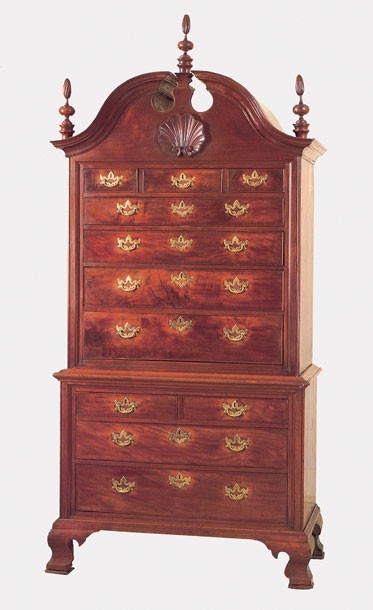
Chest-on-chest, Philadelphia, Pennsylvania, 1730–1745. Mahogany with unrecorded secondary woods. H. 95", W. 44", D. 23 1/2". (Private collection; photo, Christie’s.)

Desk-and-bookcase, London, 1720–1730. Oak with pine; japanned decoration. (Courtesy, Metropolitan Museum of Art, gift of James DeLancey Verplanck and John Bayard Rodgers Verplanck.)
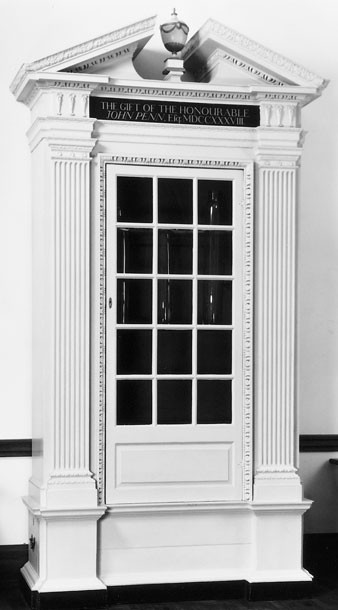
Case for an air pump by John Harrison, Philadelphia, Pennsylvania, 1739. White pine; painted. H. 130 1/2", W. 71 1/4", D. 20 1/4". (Courtesy, Library Company of Philadelphia.) Josiah Claypoole advertised desk-and-bookcases with “Peidment” heads in 1739/40.
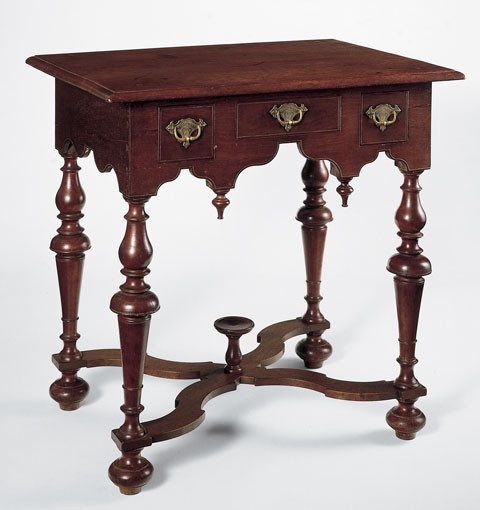
Dressing table, Philadelphia, Pennsylvania, 1715–1725. Walnut with white cedar and yellow pine. H. 29 3/4", W. 33 3/8", D. 20 1/8". (Private collection; photo, Gavin Ashworth.)

Dressing table attributed to Joseph Claypoole or George Claypoole, Sr., Philadelphia, 1725–1740. Mahogany and maple with white cedar and yellow pine. H. 30", W. 34", D. 21 1/4". (Courtesy, Israel Sack, Inc.) The two over two drawer arrangement seen here was common during the 1730s.
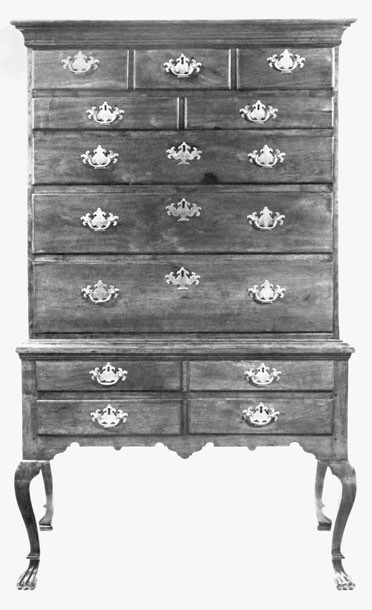
High chest attributed to Joseph Claypoole or George Claypoole, Sr., Philadelphia, Pennsylvania, 1725–1740. Walnut with unrecorded secondary woods. H. 71 1/2", W. 41", D. 21 1/2". (Courtesy, Israel Sack, Inc.)
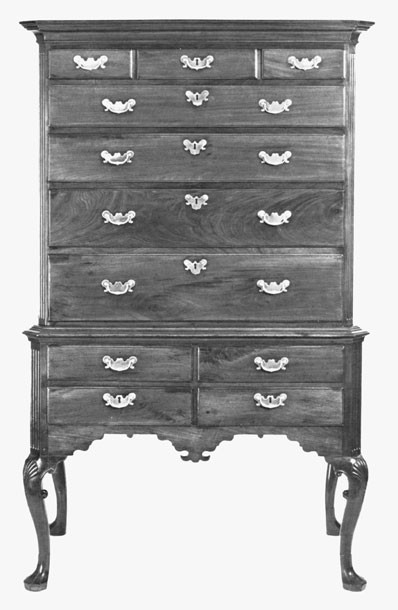
High chest attributed to Joseph Claypoole or George Claypoole, Sr., Philadelphia, Pennsylvania, 1730–1750. Mahogany with unrecorded secondary woods. H. 71 1/2", W. 43 1/2", D. 22 7/8". (Courtesy, Israel Sack, Inc.)

Dressing table attributed to Joseph Claypoole or George Claypoole, Sr., Philadelphia, Pennsylvania, 1725–1740. H. 29", W. 34 1/2", D. 20 1/4". (Private collection; photo, Christie’s.)

High chest attributed to Joseph Claypoole or George Claypoole, Sr., Philadelphia, Pennsylvania, 1740–1750. H. 93", W. 42", D. 22 1/4". (Private collection; photo, Sotheby’s.)
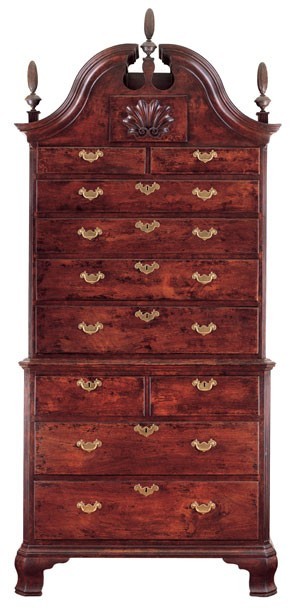
Chest-on-chest signed “Geo. Claypoole, Jr.,” Philadelphia, Pennsylvania, ca. 1754. Walnut with yellow pine and white cedar. H. 97", W. 43 1/4", D. 22 1/2". (Private collection; photo, Gavin Ashworth.) Presumably, George Jr. made this piece shortly after completing his apprenticeship.
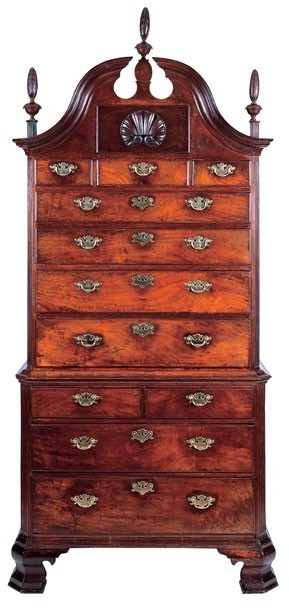
Chest-on-chest, Philadelphia, Pennsylvania, 1740–1750. Walnut with tulip poplar and pine. H. 93", W. 42 1/2", D. 23 1/2". (Private collection; photo, Graydon Wood.)

Detail of the carved shell on the upper drawer of the chest-on-chest illustrated in fig. 26.

Chest of drawers attributed to George Claypoole, Sr. or George Claypoole, Jr., Philadelphia, Pennsylvania, 1755–1770. Walnut with unrecorded secondary woods. H. 31 1/4", W. 36", D. 21". (Courtesy, Israel Sack, Inc.)
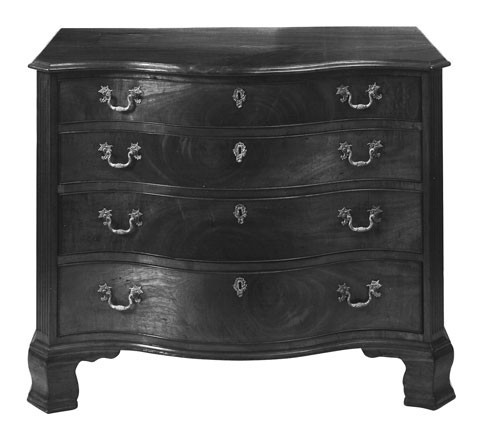
Chest of drawers bearing the label of Jonathan Gostelowe, Philadelphia, Pennsylvania, 1781–1793. Mahogany with tulip poplar, white cedar, and yellow pine. H. 37 1/4", W. 47 1/4", D. 25 1/2". (Courtesy, Cliveden, a National Trust Historic Site.)
Despite ongoing research, recent museum exhibitions, and market demand, only a few Philadelphia case pieces in the late baroque, or “Queen Anne,” style can be confidently attributed to a specific cabinetmaker or shop tradition. Similarly, the scarcity of dated case pieces has prevented scholars from developing a chronology of forms and stylistic conventions for Philadelphia furniture made during the second quarter of the eighteenth century. To begin redressing this problem, this article will examine the formal attributes and historical context of a small group of furniture associated with members of the three generations of Claypoole family joiners whose working dates collectively encompassed most of the eighteenth century. Distinctive or idiosyncratic stylistic and structural details provide a benchmark for beginning to attribute other work to these individuals, whereas more generic features document prevailing tastes and establish a rough chronology for shifts in form and ornament.
Among the constellation of immigrants who participated in William Penn’s great experiment in the New World, James Claypoole (1634–1687) must have been among the most colorful. The progenitor of the Philadelphia branch of his family, James was one of fourteen children born to John and Mary (Angell) Claypoole—prosperous Puritan landowners who resided at the Manor of Northborough in Northampton Shire (fig. 1). After serving an apprenticeship in Bremen, Germany, James achieved success as a merchant in London. He was a member of the Church of England and enjoyed a limited brush with fame after his oldest brother married Oliver Cromwell’s daughter. Shortly after Cromwell’s fall, James converted to Quakerism. He became a close friend of William Penn, and frequently entertained George Fox, George Whitehead, and other prominent members of the Society of Friends. Like many Quakers, Claypoole was persecuted for his faith. When authorities locked the doors of the Gracechurch Street Meeting on April 8, 1682, Claypoole responded by preaching to the congregation in the street. He was summarily arrested, fined, and imprisoned for seventeen days. Similar, and often harsher punishments, compelled many English Quakers, like Claypoole, to find a more tolerant and welcoming home.[1]
James purchased 5000 acres of land in Pennsylvania in 1681 and another 5000 acres in 1683 (fig. 2). After his initial purchase, he sent servants to plant a garden, buy livestock, and build a house on the town lot he received for being one of the original participants in Penn’s new experiment. “In a few years,” he wrote, “we hope to have corn and wine and cattle.” Like many of his fellow Quakers, Claypoole was optimistic about his future in the New World: “I hope to carry 10 or 12 servants from hence, and many people that love us well are inclined to go when we go. William Penn himself and family goes this Summer, and probably about 1000 people. He is so much my friend that I can have anything in reason I desire of him.” After several delays, James set sail on July 24, 1683, with his wife, their seven children, and four servants.[2]
When they arrived the following October, the Claypooles received a warm welcome from William Penn, their Quaker friends, and the servants who had recently built him “a house like a barn without a chimney.” Measuring forty feet by twenty feet, James’ residence had a dry cellar and “proved an extraordinary conveniency for securing our goods and lodging [his]...family.” The following spring, he built a proper house, reputedly the first brick one in Philadelphia. “It was a double two-story brick house, had four leaden-framed windows in front, and the same in the rear...with a beautiful south exposure, down a descending green into the pleasant Dock Creek” (fig. 3).[3]
Notwithstanding his resources and social connections, Claypoole struggled to prosper in his new environment. His wealth and image within the Quaker community suffered because of his involvement with the Free Society of Traders. As a founding member, treasurer, and major investor, Claypoole had to defend his actions in court when the society failed. These proceedings as well as Claypoole’s aggressive pursuit of public positions embarrassed his peers. However, he eventually served as a judge of the Provincial Court and Register General and was poised to be one of five governors of the colony when he died in 1687. Although numerous debtors defaulted on loans (including his brothers John and Norton), Claypoole’s appraisers valued his estate at £481.10.3 not counting several thousand acres of land.[4]
Despite their friendship, William Penn referred to Claypoole as a “sly spirit—inclinable to be to inferiors insolent, to superiors creeping—he is the man of all the province that...is least well spoken of.” Accusations of bribery and Claypoole’s ownership of slaves did little to improve his status within the Quaker community. Other members of the family had similar problems. In 1687, James’ eldest son John got into trouble in Barbados and had to flee to Pennsylvania where he worked as an assistant to Thomas Holme, the surveyor general. John later became sheriff of Philadelphia, but he was dismissed for “lameness and misbehaveor” after releasing pirates and allowing them to walk the streets on hot summer days.[5]
James Claypoole’s youngest son Joseph (1677–1744) arrived in Philadelphia at about age six. With four older brothers, the younger Claypoole was not destined to inherit a large share of his father’s estate. Consequently, Joseph elected to enter the joiner’s trade. Joiners were in great demand during this period, as indicated by James’ frequent letters asking London acquaintances to encourage carpenters and joiners to immigrate. In 1683, he wrote: “I desire thee, if thou canst hear of a carpenter, or joiner that will go over as a servant, let me know of it. Such may have as good terms from me as any.” Another letter written eight years later implies that only one cabinetmaker and one joiner were active in Philadelphia in 1691, although documentary evidence indicates that at least eleven men capable of making furniture worked in the Delaware Valley region. Such skilled labor remained in high demand well into the eighteenth century.[6]
According to furniture historian William MacPherson Hornor, Joseph Claypoole “learned his trade [in Philadelphia]...probably with Charles Plumley; and [was] in business for himself by July 1708.” Although Hornor’s statements cannot be verified, Claypoole was undoubtedly working as a joiner by 1710 when he received cash from merchant John Moore for an order on joiner Edward Evans’ account. This indicates that the two joiners were acquainted and suggests that Claypoole may have worked as a journeyman in Evans’ shop (fig. 4). The latter joiner is documented in Philadelphia in 1702, but he may have been working there earlier. If so, he is another possible candidate for Joseph’s master. Claypoole probably began serving a seven-year apprenticeship at age fourteen, thus completing his term about 1697. Plumley’s inventory, taken in 1708 by joiner John Jones and Joseph Shippen, lists two indentured servants or apprentices—David and Isaac—who had not completed their terms, but it does not mention Claypoole. At any rate, Claypoole was one of the earliest joiners trained in the city.[7]
During his career, Claypoole received commissions from several prominent clients. He made “packing chests” and an “oval table” (fig. 5) for James Logan between 1712 and 1714, did unspecified work for Isaac Norris in 1713, and billed James Bonsall £18.4.3 for “joinery” in 1725. Like many joiners and cabinetmakers, Claypoole also made coffins. He received £5.5 for a “Mahogany Coffin of ye Best fashion” from merchant Richard Hill’s estate in 1729 and charged Nathaniel Allen, executor of his father’s estate, £3.5 for a coffin on August 28, 1736.[8]
Joseph Claypoole was approximately sixty when he signed his will in 1738. His inventory taken six years later lists a variety of furniture forms—some undoubtedly made by him—including two chamber tables, two tea tables, a maple cabinet, two large cedar chests, two oval tables (one large and one small), a black walnut desk, eighteen chairs, a spicebox, and a walnut book frame. He left his daughter Edith (1723–1800) a “black walnut Drawers case upon case and ye largest cedar chest” and his son James (1720–1796) “a maple cabbenet and black walnut writing desk.” Joseph’s son George (1706–1793) received a parcel of land and his other son Josiah (1716/17–1757) inherited his tools, wood, and hardware. On May 18, 1738, the Philadelphia Gazette reported:
Mr. Joseph Claypoole, Joyner, has left off his Trade; and has given his Stock and Implements...to his son [Josiah]...who has removed from his shop in Walnut Street to the Joyner-Arms in Second Street...where all Persons may be supplied with all Sorts of Furniture of the best Fashion; as Desks,...Chests of Drawers,...Dining Tables, Chamber Tables, Tea Tables and Sideboards; he having the largest and oldest Stock of Timber, of the Produce of this country and the West-Indies, of any in this Province, some of which having been in Piles near 25 Years; he has likewise a Parcel of choice curl’d Maple; and a large Parcel of choice Wood for bedsteads, and a fine Sortment of the best and newest fashioned brass Work Furniture, lately imported from London.
In placing this advertisement, Josiah hoped to capitalize on his father’s reputation and retain his patrons and business contacts. At the time of Joseph’s retirement, Josiah was only twenty-one, having married Sarah Jackson at Christ Church a year earlier. Presumably both Josiah and his brother George apprenticed with their father, and Joseph’s retirement seems to coincide with the completion of Josiah’s apprenticeship. The fact that Joseph left his tools and materials to Josiah suggests that George was established in his trade. Despite the elder Claypoole’s best efforts, Josiah’s career went awry, and he fled to Charleston, South Carolina, accused of theft.[9]
Although no information pertaining to Josiah’s alleged crime survives, he faced prison, public whipping, or banishment if convicted. While it is possible that he was banished after a trial, it is more likely that he moved to avoid prosecution. He probably chose Charleston as his new home because it was the birthplace of his father’s first wife Rebecca Jennings (d. 1715), and he probably had relatives living there. Josiah never returned to Philadelphia, and his name appears occasionally in Charleston newspapers and documents until his death in 1757. In his first Charleston advertisement, Josiah gave notice that:
Persons may be supplied with all sorts of Joyner’s and Cabinet-Maker’s Work, as Desk and Book Cases, with arch’d, Peidiment or OG heads, common Desks of all sorts, Chests of Drawers of all Fashions, fluited or plain; all sorts of Tea Tables, Side-Boards and Waiters, Rule joint Skeleton Tables, Frames for Marble Tables, all after the newest and best fashions, and with the greatest Neatness and Accuracy by Josiah Claypool from Philadelphia, who may be spoke with at Capt. Crosthwatte’s in King-street, or at his shop next door to Mr. Lorimer’s near the market square, he has Coffin Furniture of all sorts, either flour’d, silver’d or plain. ...He will warrant his work for 7 years,...The ill Usage of careless Servants only excepted.
Like his father, Josiah appears to have been capable of producing a wide range of stylish, structurally complex furniture. The products of Josiah’s shop at “the sign of the Cabinet and Coffin” were clearly well received, and his business seems to have gotten off to a strong start. In the April 9, 1741, issue of the Charleston Gazette, he advertised “Coffins of any sort, made cheaper and better than any ever made in this Town” and apologized if “a constant Hurry of Cabinet Work” had caused him to disappoint “several good Customers.” To remedy the situation, Josiah promised to employ “two good Workmen from London” so he would have the “Capacity to suit any Person who shall favour me with their Employ.” One of his “good workmen” ran away almost immediately. On August 9, 1742, Claypoole offered a £25 reward for “an indented servant from London, named Robert Allen, by Trade a Carpenter, but can work at the cabinet maker’s Business.” Claypoole was still in business in February 1744/45, but his later advertisements imply financial duress. By April 18, 1748, he was involved in bankruptcy proceedings precipitated by a suit by William Greenland.[10]
Claypoole’s only documented commission occurred a year before his death, when the vestry of St. Johns Parish in Colleton County agreed to pay him £192 and £100 board for the “Speedy Repairing of the Parish Church.” The vestry minutes describe him as a “carpenter,” but there is no reason to assume that Josiah had given up the cabinetmaking trade. He was “in custody” by February 6, 1757, when the vestry “advanced to Mr. Claypole as pr Receipt £15 / To do. paid his Suit when in custody 103.” Perhaps the suit filed by Greenland caught up with Josiah, and the church endeavored to get him out of jail so he could undertake the repairs. Claypoole died that same year, possibly while still in prison.[11]
Josiah’s personal life was equally troubled. An undated entry in the Register of St. Andrew’s Parish documents the birth of his and Sarah’s son John. The child was baptized on September 15, 1756, and, sadly, died the following month. Sarah suffered the “melancholy necessity” of procuring two more coffins during the following year: “Thomas son of Josiah Claypoole Decsd. and Sarah his wife buried Octr. 23rd 1757 Interd without a minister.” Sarah’s fate after this date is unknown, but the Claypoole line in Charleston evidently came to an end in 1757.[12]
Josiah’s brother George continued the family’s trade in Philadelphia, and was apparently very successful. In 1783, the latter paid $200 in occupational taxes, an amount surpassed only by Thomas Affleck ($250), and matched only by Benjamin Randolph and William Cox. Bills of sale document a wide range of objects produced in George Claypoole’s shop. He made Quaker merchant John Reynals (Reynell, Reynolds) two bedsteads, a square dining table, and a chamber table in 1738 and a square mahogany tea table the following year. Reynals must have been pleased with George’s work, since his transactions with the cabinetmaker continued for another twenty-four years. During this period Reynals paid Claypoole for rudimentary tasks, such as “wheting and setting a saw” and “mending a tea table & new mouldin,” and commissioned costly pieces of furniture. In 1754/55, Claypoole billed the merchant for a “large double desk & leather to coverit,” a “mahogany clockcase of ye best fashion,” and a “Large pillar and claw table with casters.” The cabinetmaker also made mahogany coffins for four of Reynals’ children. Other Quaker clients included Edward Shippen, Jr., who paid Claypoole £14 for a “walnut double chest of drawers with archt head” in 1754.[13]
George Claypoole’s status within the cabinetmaking community is confirmed by his 1772 bill to Samuel Meredith (1741–1817) listing an extensive array of furniture valued at £130.2.7. Meredith was a signer of the Non-Importation Agreements, a general in the Continental Army, a delegate to the Continental Congress, and the first treasurer of the United States. His order coincided with his marriage to Margaret Cadwalader (b. 1753), whose brother John was furnishing his Philadelphia townhouse about the same time. Claypoole’s bill listed eighteen mahogany chairs, two dining tables, two card tables, a breakfast table, a walnut clothes press, a walnut chest of drawers, a mahogany bedstead and cornice, a mahogany sofa, a mahogany easy chair, and a frame for a marble slab. Although none of these objects can be identified today, the cost of several pieces was quite high. The card tables were six pounds each and the sofa was £10.14.6. By comparison, the pair of “commode card tables” and a large commode sofa that Cadwalader purchased from Thomas Affleck in 1771 cost five pounds each and ten pounds respectively, although that valuation may not have included the carving. Similarly, Meredith’s mahogany chairs cost three pounds each (totaling fifty-four pounds), an amount sufficient for an elaborate set. Like Affleck, Claypoole may have subcontracted carving to specialists.[14]
Although no furniture signed by George or Josiah is known, the former’s bills and the latter’s advertisements offer some insight into their and their father’s work. Josiah’s reference to “Desk and Book Cases, with arch’d, Peidment or O G Heads” two years after moving to Charleston suggests that he learned to make similar furniture in Joseph’s shop. Joseph probably began making double-case forms with complex pediments, along with “all sorts of tea tables and sideboards,” by the 1730s. During the preceding decade, most double case forms had flat tops, and tea tables and sideboards were not in common usage. The elder Claypoole probably used the term “sideboard” to refer to tables with either wooden or marble tops, whereas his son was more specific. Josiah advertised “frames for marble” (fig. 6) and apparently used the term “sideboard” to refer to a frame with a wooden top. The “arched,” “pediment,” or “ogee heads” probably referred to examples like those on the case pieces illustrated in figures 15, 19, and 7 respectively. Presumably Josiah learned to make all of these variants in Philadelphia.[15]
The high chest signed by Joseph Claypoole in 1743 (figs. 7-9) confirms that his shop was producing such complex pediments, and indicates that he and, probably, his sons made case furniture and tables with pad feet and claw-and-ball feet. Although the chest is the earliest dated Philadelphia piece with the latter foot form, claw-and-ball feet were undoubtedly popular in the city before 1743. Such feet were popular in London by the 1730s, and the regular trade between the two cities supports the hypothesis that this design element was in use well before Joseph fashioned this high chest. More importantly, the design and modeling of the feet on the chest (fig. 9) suggest that Joseph, or a specialist he contracted, had carved similar examples many times before.[16]
The signature, initials, and date on the chest are somewhat puzzling given the fact that Joseph Claypoole announced his retirement in 1738. When Josiah fled Philadelphia to avoid incarceration, he probably left behind tools and most of the materials he had received from his father. It is conceivable that Joseph resumed his trade, or that he made the chest to fulfill one of his son’s obligations. The elder Claypoole’s name and the date are written in large script on the inside bottom boards of the upper case, and his initials are in several places. Although this may reflect pride that Joseph took in the object’s completion, there is no evidence that he made it for himself. He died in early 1744, and no high chest is listed in his inventory.[17]
All of the drawer fronts of Claypoole’s chest have curly maple cores, thick (three-eighths inch) mahogany veneer, and applied cockbeading. The small drawers have poplar frames and yellow pine bottoms nailed to the sides and back. Although the large drawers are composed of the same woods, their bottoms have thin strips of wood glued to each side and a beveled front edge that engages a groove in the front. Oak blocks attached to the drawer fronts function as stops, and strips of wood nailed to the case sides support them.
The most distinctive feature of the chest is its ogee head, which Joseph attached using two sliding dovetails (now missing). Ornamented with two concave shells, the basic design of the pediment has precedents in both English and Philadelphia case furniture from the 1730s, but it is unique among high chests. Shells on desk-and-bookcases may have inspired those on the Claypoole chest, although the former are usually concealed as components of the bookcase interior. The carving on the knees of the chest is also unusual. Rendered in shallow relief, the shells resemble those on Newport, Rhode Island, furniture more than those on contemporary Philadelphia examples.
The high chest’s ogee head ties it to three Philadelphia desk-and-bookcases (figs. 10-12). Two of these desk-and-bookcases (figs. 10, 11) are from the same shop and share enough details with the chest to warrant a tentative attribution to one of the Claypooles, most likely Joseph or his son George. The desk-and-bookcase illustrated in figure 10 reputedly descended in the Wistar family of Philadelphia and is the only one with original finials. Its lower drawer is branded “WA,” but the initials do not match those of any known member of the Wistar family or any Philadelphia cabinetmaker active during the period. Oral tradition maintains that James Logan purchased the third desk-and-bookcase (fig. 12) from Philadelphia joiner Stephen Armitt (1705–1751). Logan’s son James married Armitt’s daughter Sarah, and the desk-and-bookcase descended through the Armitt family to Mrs. John F. Doremus, who donated it to Stenton (fig. 13), the elder Logan’s home just outside Philadelphia. James Sr. probably commissioned the piece just before or after building his residence, which was under construction from about 1725 to 1730. With its mirrored doors and exotic hardwoods (fig. 14), the Logan desk-and-bookcase was clearly the most expensive of the three related examples. Like the house in which it stood, it reflected its owner’s wealth, education, and taste.[18]
The desk-and-bookcases illustrated in figures 10–12 are among the most elaborate case forms made in Philadelphia during the 1720s and 1730s. As early advertisements and bills indicate, cabinetmakers offered a wide range of structural and decorative options for this furniture form. Arched
pediments occur on several contemporary desk-and-bookcases, some of which have carved ornaments, mirrored doors, and other expensive features (fig. 15). By the mid-1740s, Philadelphia cabinetmakers had abandoned ogee and arched heads for scrolled pediments like the one on the chest-on-chest illustrated in figure 17.
Although a Philadelphia desk-and-bookcase similar to the Logan and Wistar examples may have inspired the pediment of the Claypoole high chest, virtually identical ogee heads occur on British furniture from the 1710s and 1720s. A desk-and-bookcase similar to Logan’s bears the signature of London joiner Peter Miller and the date 1724, and another example signed by William Palleday appears to be contemporary with both pieces. English case furniture of this caliber was undoubtedly present in the colonies during the 1720s and 1730s. Sir Danvers Osborn (d. 1753), who served as Royal Governor of New York in 1753, owned the japanned desk-and-bookcase illustrated in figure 18. Architectural books depicting related pediments were available in Philadelphia (fig. 16), but imported furniture was the most prevalent design source for joiners like Armitt and the Claypooles.[19]
A chest-on-chest (fig. 17) probably made by Joseph or his son George has an enclosed arched pediment and a molding surrounding the upper and lower ranks of drawers. This molding creates a visual effect reminiscent of the pseudo-pilasters flanking the drawers on the signed high chest (fig. 7). The former case piece differs from the latter in having an integral pediment rather than a removable one, but both objects have drawers with thick veneer and cockbeading. Ogee bracket feet were a relatively new option when the chest-on-chest was made. Such feet remained popular through the remainder of the colonial period, as did straight bracket feet on less expensive or more austere designs.
Like the ogee heads on Joseph Claypoole’s high chest (fig. 7) and the aforementioned desk-and-bookcases (figs. 10–12), pitch pediments are rare on Philadelphia case pieces in the late baroque style. This is surprising given the fact that pitch pediments appear in many contexts in British architectural books; in local buildings such as Stenton, Graeme Park (built ca. 1722), and Hope Lodge (built ca. 1723, current interior installed ca. 1735); and on seventeenth- and eighteenth-century British case pieces. A pump cabinet made by John Harrison for the Library Company of Philadelphia in 1739 (fig. 19) is the earliest documented Philadelphia case piece with this detail, but Joseph Claypoole probably made furniture with “pediment heads” at the same date if not earlier.[20]
Given the years of Joseph’s activity in the cabinet trade, he undoubtedly witnessed many changes in local and international furniture styles. The turned legs of the baroque style (fig. 20) were still popular in 1726, when Joseph’s competitor John Head made a high chest and matching dressing table (Philadelphia Museum of Art) for Caspar Wistar. By the late 1720s, Philadelphia cabinetmakers were producing similar case forms with angular cabriole legs and plain or carved “Spanish” feet (see figs. 21, 22). Round cabriole legs with paneled (see fig. 23), slipper, and trifid feet became fashionable during the 1730s, and as Joseph Claypoole’s signed high chest indicates, claw-and-ball feet were an option by 1743, if not earlier. Joseph must have been at the vanguard of Philadelphia cabinetmakers catering to the latest tastes, but both he and his sons had to respond to the demands of conservative patrons as well as more progressive ones (see fig. 24). Evidence suggests that Philadelphia cabinetmakers produced old-fashioned and avante garde forms simultaneously as did their counterparts in other colonial cities.[21]
The dressing table and high chests illustrated in figures 21–23 show how the Claypooles responded to changing tastes during the second quarter of the eighteenth century. Separating the work of Joseph and his sons is impossible at this time owing to the fact that he trained George Sr. and Josiah, and no documented work by them is known. It is unlikely, however, that any of the aforementioned objects are by Josiah given his early move to Charleston. Like the high chest signed by Joseph, the example illustrated in figure 23 has a lower rail with a distinctive “fish tail” pendant and unusual combination of cyma and astragal elements. The cornice and waist moldings of the two chests vary slightly, but they are much more alike than they are different. Although it is tempting to date the high chest and dressing table with “Spanish feet” (figs. 21, 22) earlier, it is possible that all of these objects were made only a few years apart. The drawer support system and partition construction of the dressing table, for example, is identical to that of the high chest with paneled feet (fig. 23). Similarly, the dressing table with turned legs probably dates from the late 1720s or 1730s since it has lip-molded drawers (fig. 24).[22]
Documentary evidence indicates that all of the Claypooles produced a standard range of case and table forms. On September 18, 1746, Thomas Penn wrote that if his mahogany parlor chairs had not “been burnt or destroyed Claypool might fit them up again, and with new seats they would be as good as ever.” Presumably, the “Claypool” mentioned in this letter was George Sr., and if so, it is likely that Penn purchased furniture as well as services from the cabinetmaker. Despite William Penn’s disparaging reference to James Claypoole, both families appear to have maintained ties throughout the eighteenth century.[23]
A high chest that reportedly descended in the Penn family (fig. 25) is one of the most fully developed case forms from the Claypoole shop tradition. Like the aforementioned pieces, it is probably by Joseph or George Sr. The cornice molding has the same sequence of ovolo and astragal elements as the cornice of the Joseph Claypoole high chest (fig. 7), and the lower rail has a pendant with bold cyma curves and an underscaled terminal. Moreover, the tympanum opening and position of the cornice relative to the lamb’s tongue “capitals” of the side chamfers are similar to those on a chest-on-chest signed by George Claypoole, Sr.’s son and namesake (fig. 26). On both pieces the lamb’s tongues are applied rather than worked from the solid.[24]
George Jr. probably trained with his father and completed his apprenticeship about 1754. Not surprisingly, the former’s chest-on-chest reflects styles current during the 1740s. Like the early chest-on-chest illustrated in figure 27, the signed example has a tympanum drawer with a relief carved shell composed of broad convex and concave segments and no applied leaf carving (fig. 28).[25]
The stylistic and structural features of the signed chest-on-chest (fig. 26) may eventually assist scholars in identifying additional work by George Claypoole, Jr. as well as other members of his family. George Sr. clearly made similar forms as indicated by his 1754 bill to John Reynals for a “Mahogany Chest of Drawers & table of the best fashion...£24.” Philadelphia patrons often ordered dressing tables to accompany both chest-on-chests and high chests. Chest-on-chests were clearly in the repertoire of all the Claypooles. Joseph left his daughter a “case of drawers case on case” valued at £4.10 in 1744; Josiah’s first advertisement in Charleston mentioned “all sort[s] of chests fluted or plain”; and George Sr. made a chest-on-chest for Edward Shippen, Jr.
The foot and base molding profiles of the chest of drawers illustrated in figure 29 are nearly identical to those on the chest-on-chest signed by George Claypoole, Jr. Both pieces also have similar returns and chamfers with three flutes. Although it is not clear which George made the chest, it is obviously the precursor to examples made by the elder Claypoole’s apprentice Jonathan Gostelowe (1744–1795) (fig. 30). Gostelowe served his term during the late 1750s and early 1760s. On July 12, 1762, Jonathan Gostelowe acknowledged his receipt of £2.19 “in full of all accounts for my master George Claypoole.” Although typically updated with “commode” fronts, most chests attributed to Gostelowe have fluted chamfered corners and bold ogee feet—details associated with the Claypooles and several of their competitors. A labeled Gostelowe chest (fig. 30) also has a top drawer with partitions for dressing or writing implements like the chest illustrated in figure 29. Gostelowe may have made such chests as late as 1793, when he advertised the contents of his shop for sale.[26]
The furniture documented and attributed to the Claypooles presents a rather fragmented picture of one of Philadelphia’s most important multi-generational shop traditions. Nevertheless, these objects and the documentary evidence surrounding them reveal how knowledge, tools, and customers were passed from father to son and from master to apprentice. The Claypooles’ extended family and their varied religious affiliations, which covered both Quaker and Anglican congregations, helped them build a commercial network that undoubtedly contributed to their success. As additional documents and objects associated with the Claypooles and their competitors emerge, scholars will begin to understand the complex community of artisans and patrons that existed in Philadelphia during the first half of the eighteenth century.
ACKNOWLEDGMENTS
For assistance with this article, the author thanks Neal Alford, Luke Beckerdite, Dr. and Mrs. John Boor, Lauren Bresnan, H.L. Chalfant Antiques, Rachel Ciba, Brian Davies, David Demuzio, Bert Denker, Susan Detweiler, Susannah Doherty, Glynnis Doucette, Jeff Groff, Morrison Heckscher, Peter Kenny, Alexandra Kirtley, Bernard and S. Dean Levy, Jack Lindsey, Alan Miller, Rick Mones, William Nacey, Pook and Pook Auctions, C.L. Prickett Antiques, Nancy Richards, Martha Rowe, Albert Sack, Philip Seitz, Kelly Seltzer, Jeanne Solensky, and Laura Stutman.
For his support of Cromwell during the English Civil Wars, James’ father John was created a baronet in 1657. By this date, however, James was apprenticed to a merchant in Bremen, Germany. In 1658 he was married by a Calvinist minister to Helen Mercer and soon returned to London to establish himself as a merchant. For more on the Claypoole family, see Evelyn Claypoole Bracken, The Claypoole Family in America (Indiana, Pa.: A.G. Halldin, 1971). Much of the Claypoole genealogy is also available online. See, for example, http://freepages.genealogy.rootsweb.ancestry.com/.
William Penn’s A Letter From William Penn, Proprietary and Governour of Pennsylvania in America, to the Committee of the Free Society of Traders (London: Andrew Sowle, 1683), p. 3, states that “the purchasers of 1000 acres and upwards are placed in the Front and High Streets and begin on Delaware Front at the South end at Number One to Proceed with the Front to the North End to No. 43.” James Claypoole was no. 14 and Samuel Carpenter was no. 16. Although Claypoole and Carpenter were neighbors, they disagreed over a debt case against the Free Society of Traders which Claypoole fought vigorously.(James Claypoole to Edward Claypoole, February 20, 1682, cited in James Claypoole’s London Letter Book, edited by Marion Balderston [San Marino, Ca.: Huntington Library, 1967], pp. 86–87, 109–10.)
Information on the house is derived from James Claypoole to Edward Claypoole, October 2, 1683, in Balderston, ed., James Claypoole’s London Letter Book, pp. 20–21. John F. Watson, Annals of Philadelphia, 2 vols. (Philadelphia, 1857), 1: 558.
Claypoole discussed his appointment as treasurer of the society in his correspondence. See James Claypoole to Edward Claypoole, April 27, 1682, in Balderston, ed., James Claypoole’s London Letter Book, p. 127. James Claypoole’s will, dated December 5, 1686, is transcribed in Bracken, Claypoole Family in America, p. 14.
Although Penn recognized Claypoole’s faults, he continued to support him and remained a loyal friend. Penn Mss, Domestic and Miscellaneous Letters, Historical Society of Pennsylvania (hereafter cited HSP), Philadelphia, as cited in Balderston, ed., James Claypoole’s London Letter Book, pp. 8, 19.
James Claypoole’s will left “Joseph, my youngest son, my plantation bordering on Lewis Creek in Sussex County which I bought from my brother, Norton Claypoole.” (Bracken, Claypoole Family in America, p. 14). Norton had preceded James to the New World and settled in Delaware. William Penn and Thomas Lloyd were overseers of James’ will, and his wife was executrix. See James Claypoole to William and Elizabeth Hard, February 14, 1683, in Balderston, ed., James Claypoole’s London Letter Book, p. 208. This letter was meant to encourage new immigrants by suggesting the opportunities that awaited them. John Goodson to John and S. Dew, June 24, 1690, as quoted in “Letters from Pennsylvania, 1691,” Pennsylvania Magazine of History and Biography 4, no. 2 (1880): 195. At least eleven joiners were working in the Delaware Valley by 1691 (Jack Lindsey, Richard S. Dunn, Edward C. Carter II, and Richard Saunders, Worldly Goods: The Arts of Early Pennsylvania, 1680–1758 [Philadelphia, Pa.: Philadelphia Museum of Art, 1999], pp. 247–54).
William MacPherson Hornor, Blue Book: Philadelphia Furniture (Philadelphia, Pa.: privately printed, 1935), p. 3. Although Hornor’s book does not contain footnotes or other citations, many of his statements have proved accurate. Joseph Claypoole was undoubtedly acquainted with Plumley. On April 17, 1711, Claypoole witnessed an exchange of property between Richard Heath and Rose Plumley, Charles’ widow. Charles Morton Smith Papers, vol. 3, nos. 18, 19, HSP. John Moore Daybook, Sept. 2, 1710, and July 28, 1716, HSP, as cited in Cathryn McElroy, “Furniture of the Philadelphia Area: Forms and Craftsmen before 1730” (master’s thesis, University of Delaware, 1970), pp. 170–72. See also Arthur Leibundguth, “The Furniture Making Crafts in Philadelphia, c. 1730–c. 1760” (master’s thesis, University of Delaware, 1964), pp. 8–14. Both authors cite additional documents pertaining to the Claypoole family. Inventory of Charles Plumley, October 15, 1708, ms 111, Philadelphia City Hall.
Raymond V. Shepard, Jr., “James Logan’s Stenton: Grand Simplicity in Quaker Philadelphia” (master’s thesis, University of Delaware, 1968). Account Book of Isaac Norris (1709– 1740), p. 104, HSP. James Bonsall Account Book, p. 93; and Richard Hill Estate, vol. 18, pp. 52–60 both HSP and both cited in McElroy, “Furniture of the Philadelphia Area,” p. 171. Claypoole also charged Hill’s estate three pounds for making 120 “pidgeon holes” for papers and other documents. In her thesis, McElroy suggests that John Willet apprenticed with Joseph Claypoole. However, Willet was born in New York and began training with joiner Aaron Goforth in 1728 (Indenture between John Willett and Aaron Goforth, April 11, 1728, Richard Hill Estate, Logan Papers, vol. 18, p. 25, HSP). In his will, Goforth left his “books, wearing apparel and working tools” to his son-in-laws Richard Hill and Thomas Campbell (McElroy, “Furniture of the Philadelphia Area,” p. 184). Account Book of Nathaniel Allen, p. 100, HSP, as cited in Leibundguth, “The Furniture Making Crafts in Philadelphia,” p. 9.
Joseph Claypoole Will, Philadelphia Wills and Inventories, ms. 81, January 18, 1738. Joseph Claypoole Inventory as cited in McElroy, “Furniture of the Philadelphia Area,” p. 170. No apprenticeship record for Josiah is known. This supports the theory that he apprenticed with his father, since formal agreements were not required for contracts between family members. In January 1738, Josiah appears in the account book of Nathaniel Allen. He paid part of his £18 debt in cash and the remainder with “9 Pickturs Sent to John Hawes of Antegua” and a “pr. of Chest of Drawers for Moley” (presumably a ship). He purchased paper and books from Benjamin Franklin, and was credited for framing 36 pictures. Account Book of Nathaniel Allen, p. 149, HSP, as cited in Leibundguth, “The Furniture Making Crafts in Philadelphia,” p. 13. Josiah advertised in the South Carolina Gazette on March 22, 1739/40, April 16, 1741, August 9, 1741/42, and April 18, 1748, research files of the Museum of Early Southern Decorative Arts, Winston-Salem, North Carolina (hereafter cited MESDA). Claypoole’s indictment is mentioned in Cathryn J. McElroy, “Furniture in Philadelphia: The First Fifty Years,” Winterthur Portfolio 13 (1979): 80. November 10 and 21, 1739, Indictments, 1717–1790, Philadelphia County Court Papers, HSP. Despite extensive efforts, the HSP has been unable to locate these papers. For more on the punishments that thieves and other criminals faced, see Theodore Thayer, “Town into City 1746–1765,” in Philadelphia: A 300-Year History, edited by Russell Weigley (New York: Barra Foundation, 1982), pp. 76–78.
Joseph married Rebecca Jennings on July 20, 1703. While there is some evidence that they married in Charleston, there is no evidence that Joseph ever worked in that city. The date and location of the marriage is referenced on http://www.Flash.net/~wlemmon/HTML/d0002/g00000.93.htm. South Carolina Gazette, March 22, 1739/40, August 9, 1741/42, February 4, 1744/45, April 18, 1748.
Vestry Minutes, St. John’s Parish, Colleton, S. C. 1734–1817, pp. 43, 44, 89, South Carolina Historical Society, Charleston, S. C., typescript in MESDA research files.
Josiah Claypoole’s first child was born just a few months after his marriage to Sarah Jackson. “Register of St. Andrew’s Parish, Berkeley County, South Carolina,” edited by Mabel L. Webber, South Carolina Historical and Genealogical Magazine 14, no. 3 (1913): 155–59, as cited in MESDA research files.
Horner, Blue Book, pp. 317–26. Bills from George Claypoole, Sr. to John Reynals, October 30, 1730–May 4, 1764, Coates-Reynell Papers, HSP, microfilm copy in the Joseph Downs Library (hereafter cited JDL), Winterthur Museum. Bill from George Claypoole, Sr. to Edward Shippen, dated paid on April 22, 1755, photocopy cataloged as ph1380, Col. 521, JDL. On October 27, 1783, George Claypoole, Sr. charged Greenberry Dorsy £10.1.1 for a mahogany chamber table (bill from George Claypoole to Greenberry Dorsey, October 27, 1783, ms. 55.528, JDL).
Bill from George Claypoole to Samuel Meredith, December 5, 1772. ms. 55.528, JDL. Samuel and Margaret were apparently married on May 21, 1772, www.FamilySearch.org. For a copy of Affleck’s bill, see Nicholas Wainwright, Colonial Grandeur in Philadelphia (Philadelphia, Pa.: Historical Society of Pennsylvania, 1964), p. 44.
There are clear affinities between Charleston and Philadelphia furniture. Future research may clarify the role that Josiah played in introducing or perpetuating such attributes into Charleston’s cabinet trade. Eighteenth-century terminology is not precise, and cabinetmakers occasionally used the same term to describe two different things. The term “ogee head,” for example, could also refer to a “scroll pediment,” or what modern collectors call a bonnet top.
Evidence suggests that Joseph or a carver in his shop executed the knee acanthus. The inside front of the upper middle drawer has a carved volute that appears to have been cut before the drawer was assembled. The upper right drawer also has an inscribed design showing the scalloping of the skirt. An Irish tea table with deeply webbed claw-and-ball feet that appears to predate the high chest was among the early furnishings of Graeme Park, built in 1721 or 1722 (Lindsey et al., Worldly Goods, p. 13, fig. 23).
Claypoole’s signature is not complete, but reads “Jos Claypoole 1743.” Since Josiah never returned to Philadelphia, this is almost certainly the signature of Joseph. Bracken, Claypoole Family in America, p. 48.
A related group of four Boston-area case pieces with ogee heads is discussed in Edward S. Cooke, Jr., “Boston Clothespresses of the Mid-Eighteenth Century,” Journal of the Museum of Fine Arts, Boston 1 (1989): 75–95. For more on Armitt and the descent of the desk-and-bookcase, see Stenton object file 72.4. Logan’s household accounts do not mention the purchase of an “escritoire,” as desk-and-bookcases like the one illustrated in fig. 12 were often called. A 1754 inventory of Stenton lists an “Escritoire with glass doors,” which may be this example. (An inventory of the Personal Estate of Sarah Logan, Deceased, taken June 4, 1754, Smith Family Papers, vol. 4, p. 182, HSP.)
Sir Danvers Osborn was appointed governor in May 1753 and took office in July. A troubled man, he committed suicide in October of that year. Christopher Gilbert, A Pictorial Dictionary of Marked London Furniture (Suffolk, Eng.: Furniture History Society, 1996), pp. 331, 337. A desk-and-bookcase similar to the Osborn example is illustrated in Geoffrey Beard and Judith Goodison, English Furniture 1500–1840 (Oxford, Eng.: Phaidon/Christie’s, 1987), p. 50. Fielded mirrors also occur on case pieces with broken-arch, or “scrolled” cornices. See Herbert Cescinsky, English Furniture From Gothic to Sheraton (Grand Rapids, Mich.: Dean-Hicks Co., 1929), p. 203.
A desk-and-bookcase with a pitch pediment reputedly made for Charles Norris in 1756 is in the collection of Independence National Historic Park. A photograph of this object is in the Decorative Arts Photographic Collection, Winterthur Museum.
John Head recorded the high chest and dressing table in his account book on April 4, 1726 (John Head Account Book, Vaux Papers, American Philosophical Society, Philadelphia.) Both pieces are in the Philadelphia Museum of Art.
A dressing table similar to the example illustrated in fig. 21, but with a skirt shaped like the high chest shown in fig. 22, is illustrated in Wallace Nutting, Furniture Treasury, 2 vols. (Framingham, Mass.: Old America Co., 1928), 2: fig. 422. A spice cabinet that also appears to be by either Joseph Claypoole or George Claypoole, Sr. is shown in Lindsey et al., Worldly Goods, p. 140, no. 9.
“Letter of Thomas Penn to Richard Hockley, 1746–1748,” Pennsylvania Magazine of History and Biography 40, no. 158 (April 1916): 226–27.
Sotheby’s Important Americana: Furniture, Folk Art, and Decorations, New York, October 15, 1999, lot 93.
Other apprentices in George Sr.’s shop included Thomas Rutter, who began his term on September 9, 1746 (Thomas Rutter Indenture, Account of Servants and Apprentices Bound and Assigned before James Hamilton, Mayor of Philadelphia [1745–1746], HSP, as cited in Liebundguth, “Furniture Making Crafts in Philadelphia,” p. 10). Further evidence that George Jr. trained in and continued to work in his father’s shop is found in a transaction between the Claypooles and Joseph Shippen in 1766. Shippen purchased a coal box, a box for a gun, a lock and a “pine case for papers.” The bill reads “Mr. Joseph Shippen to Geo. Claypoole” but is signed “received the above in full George Claypoole Junr” (bill from George Claypoole, Sr. to Joseph Shippen, January 28, 1766, Shippen Papers, vol. 10, pp. 73, 77, HSP). Either the bill was simply not specific in its initial reference to Claypoole, or it indicates that George Jr. continued to be active in his father’s shop. In 1770 George Sr. drafted his will leaving his namesake “all...[the] half inch walnut now cut out and planed, and lying in the loft over...[his] shop.” The elder George lived another 23 years, and he and his son died in the yellow fever epidemic of 1793 (Liebundguth, “The Furniture Making Crafts in Philadelphia,” p. 10). The elder George and his wife Catherine were buried in St. Paul’s Episcopal Churchyard; his wife’s death date is noted on the gravestone as March 31, 1770, and his is marked October 3, 1793. Numerous sources note his death date as 1770, which is incorrect.
Deborah Federhen, “The Serpentine-Front Chests of Drawers of Jonathan Gostelowe and Thomas Jones” Antiques 133, no.5 (May 1988): 1174–83.
